I have a batch query that I execute from SQL Server Management Studio (v18.5) that has multiple dynamic pieces and generates multiple query results that I would like to export to Excel automatically from the SSMS console, if possible.
In the batch query, I first select a unique set values from 1 column in a table, and I iterate through that list to build a dynamic pivot query using the value from the list. Each pivot query will have a different set of results for each value.
For example: unique list that I loop through:
Type
-----
Fan
Compressor
Belt
Motor
Filter
The pivot query results for Fan will have a unique set of columns that are different from the pivot query results for Compressor.
Fan pivot columns
FanID, Speed, Weight, Blade Size, RPM
Compressor pivot columns
CompressorID, HP, Voltage, Amps, Height,
Each time I loop through the Type list, I would like to export the pivoted query results to an Excel file. Ideally, I would like to export to 1 workbook with each Type's pivoted query results having its own worksheet. Since each pivoted query result will have a difference set of columns, I cannot compile all of the query results into 1 table and then export to Excel (or csv). Trying to avoid having multiple files, one for each type.
UPDATE:
I have added the following to my batch query:
INSERT INTO OPENROWSET(''Microsoft.ACE.OLEDB.12.0'',''Excel 12.0; Database=C:\temp\tesxt.xlsx;'',''SELECT * FROM [Sheet1$]'')
But I'm getting the following error:
Cannot create an instance of OLE DB provider "Microsoft.ACE.OLEDB.12.0" for linked server "(null)"
I ran these two commands prior to attempting the code above:
EXEC sp_configure 'show advanced options', 1
RECONFIGURE
EXEC sp_configure 'Ad Hoc Distributed Queries', 1
RECONFIGURE
UPDATE: I was hoping there was a down and dirty export option that would eliminate the need to write an application.
I tried the BCP approach, but I was unable to get it to work. I changed the server name to mine and the database name to mine; no luck. The @sql variable is my dynamic pivot query. Tried different bcp command parameters with no luck.
UPDATE: Getting a little closer; I replaced @sql from the bcp command above with a simple select query and the command executed, creating a new .csv file for each "Type" in the type list; there must be something in the complex dynamic pivot @sql string that bcp doesn't like. Regardless, I know the underlying plumbing of having bcp export query results to a csv file is working.
UPDATE:
Here is the @sqlCommandForBcp
set @sqlCommandForBcp = 'bcp "'+ @sqlForPivot + '" queryout "' + @filePath + @fileName + '" -S CLT00ZB1\SQLEXPRESS2019 -T -t , -d Repository -c'
This is a print out of the @sqlCommandForBcp which includes an example of the real pivot query. Each iteration through the Type list generates a new pivot query with different columns.
bcp "SELECT ProductID, KWGAID, ShortDesc, VendorID, Segment, Category, Type, SubType,[Airflow], [Amperage], [Bearings], [Cross Reference], [Diameter], [Enclosure], [Footnotes], [Frame], [Frequency], [Item], [Motor Type], [OEM], [Options], [Power], [Replacing], [Rotation], [RPM], [RPM-Range], [Series-Brand], [Shaft], [Speed], [Stack Size], [Voltage]
FROM
(
SELECT ''+ CONVERT(nvarchar(8), a.SeqNum) + ' | ' + '' + a.TypeID + '' + ' | ' + CONVERT(nvarchar(1), a.IncludeName) + ' | ' +
a.Value as Value, a.Name, p.KWGAID, p.SeqNum as ProductID, p.ShortDescription as ShortDesc,
p.VendorID, p.VendorPartNumber, s.Name as Segment, c.Name as Category,
t.Name as Type, st.Name as SubType
FROM Product p INNER JOIN
Segment s ON p.SegmentID = s.ID INNER JOIN
Category c ON p.CategoryID = c.ID INNER JOIN
Type t ON p.TypeID = t.ID INNER JOIN
Vendor v ON p.VendorID = v.ID INNER JOIN
SubType st ON p.SubTypeID = st.ID INNER JOIN
Attribute a ON p.SeqNum = a.ProductSeqNum INNER JOIN
AttributeType at ON a.TypeID = at.ID
Where v.ID = 132 AND c.Name like 'Blower Motors'
) as PivotData
PIVOT
(
Max(Value)
For Name IN ([Airflow], [Amperage], [Bearings], [Cross Reference], [Diameter], [Enclosure], [Footnotes], [Frame], [Frequency], [Item], [Motor Type], [OEM], [Options], [Power], [Replacing], [Rotation], [RPM], [RPM-Range], [Series-Brand], [Shaft], [Speed], [Stack Size], [Voltage])
) as PivotResults Order by Segment, Category, Type, SubType, ShortDesc" queryout "C:\Temp\Blower Motors.csv" -S CLT00ZB1\SQLEXPRESS2019 -T -t , -d Repository -c
UPDATE:
Another step forward. Inserting the pivot query results into a temp global table and then selecting that table in the bcp command works! I am now getting results exporting to individual csv files; however, I'm seeing two issues. 1. the results do not include column headers; I have to have those and each pivot queries results will have different columns. 2. There are commas in the query results and that is throwing off the exported results. I read through the bcp documentation and didn't see a command switch to force column headers; also not sure how to handle the commas in the query results.
Update: I finally gave up on the tSQL approach with SSMSand starting writing a solution in another language. This was solely for a temporary cleanup project, not a long-term production solution. I’m using Access linked via ODBC and some VBA to handle looping through the list of Types and exporting the pivoted (CrossTab in Access) results to Excel. With VBA I have everything I need to create workbooks on the fly and insert worksheets, etc.
I learned a good bit about bcp and linked servers within SQL, but there just isn’t a very simple solution for what I’m wanting to do.
Not sure who should get the points here. Thanks to all for the input.


